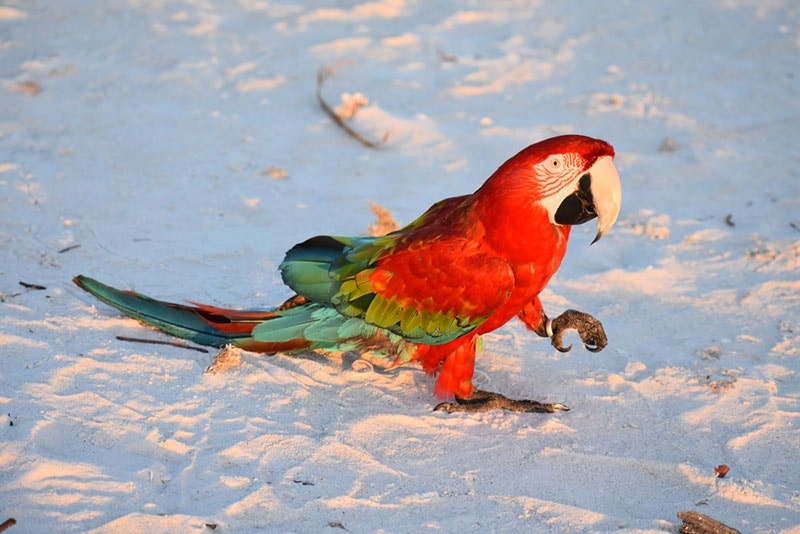The Ruby Macaw is a hybrid cross between a Scarlet Macaw and a Green-winged Macaw and is quite attractive. Hybrids are usually bred for color rather than personality, so their characteristics can be uncertain.
This is a first-generation hybrid macaw, meaning its parents are two species of naturally occurring macaws. Because the offspring are a mixture of more than one type of macaw, they are influenced by the traits and characteristics of both of their parents. Fathers have the dominant gene, so this will generally influence the offspring’s coloration and overall appearance. The Ruby inherits its gorgeous coloring from these two striking parents.
The parents of the Ruby Macaw are two very popular types of birds. The Scarlet Macaw is one of the most highly favored macaws, and is often described as both beautiful and striking. It has been the best-known South American parrot for over 100 years. The other parent, the Green-winged Macaw, has been one of the most popular pet birds in the trade, renowned not only for its beauty but for its gentle, amiable nature.
The personality of a Scarlet is such that it requires good socialization and a firm consistent hand in training, especially as it matures. The Green-wing is a very gentle, affectionate and sensitive macaw. The Ruby can have the characteristics of the Scarlet, but it can also incorporate the gentle nature of the Greenwing. Ruby Macaws can be a very affectionate and playful, good talkers, and fun pets that are very beautiful.
See hybrid information, breeding combinations, and photos of hybrid macaws on the Hybrid Macaws page.
- For information about the care of Macaws see: Guide to a Happy, Healthy Macaw
Scientific name
The Ruby Macaw is a first-generation hybrid macaw. It is a cross between a Scarlet MacawAnodorhynchus macao and a Green-winged MacawAra chloroptera.
Distribution
ThIs is a captive-bred hybrid macaw. Hybrid macaws are rarely found in the wild.
Description
Ruby Macaws are exceedingly striking in coloration, and rank right up there among the most colorful of the Macaws. They are full-sized Macaw and can learn to talk with a general vocabulary of about 15 or more words or expressions. A Ruby Macaw needs good socialization and a firm consistent hand in training, especially it matures.
In the mating pair, the male has the dominate gene. Often times the overall coloration of the Ruby Macaw can be very similar to the Green-winged Macaw and they are often mistakenly thought to be a Green-winged Macaw. Coloration varies however, even in babies from the same clutch.
- If the male parent is a Green-winged Macaw:
The offspring will generally have the same size body and head as the father. What distinguishes the Ruby from the Green-winged father is the center band of feathers. These feathers can be a mixture of varying amounts of yellows and oranges, and they can be edged with different shades of yellows and oranges. - If the male parent is a Scarlet Macaw:
The offspring will generally have the head and body size of a Scarlet. The amount and coloration of the facial feathers will also generally be more similar to those of the respective father. There is very little facial feathering on the offspring of a Scarlet father.
Size – Weight
The Ruby Macaw is a full-sized macaw, very close to the same size as its parentage. They will reach over 2 pounds. The length of the Scarlet Macaw is up to 85 cm (33.5 inches) and the Green-winged Macaw is up to 90 cm (35.5 inches). A Ruby Macaw will reach a size somewhere in the middle and possibly closer to that of the father.
Care and feeding
A roomy cage is required unless the bird is to be let out for extended periods. Many birds can spend most of their time on a playpen or parrot perch. In the wild their parent species eat a variety of palm nuts, fruits, seeds, and possibly vegetable matter from the treetops. Provide them with a good parrot mix that includes formulated foods, seeds, nuts, and dried fruits. They will also enjoy fruits and vegetables.
- See About Macaws: Housing and About Macaws: Care and Feeding for more information.
Social Behaviors
They are a typical macaw. Can be cranky at times and may even be a one-person bird or only like men or women unless well socialized with lots or folks. See About Macaws: Social Behaviors for information on developing a well-rounded friendly macaw. (Also information on handling and activities)
Breeding/Reproduction
Because it is a hybrid it is generally not bred.
Sexual differences
Potential Problems
Can be noisy (as can all macaws). See About Macaws: Potential Problems for information on illnesses.
Availability
This bird is somewhat hard to find and fairly expensive. There are more and more breeders however and they are becoming more common.
Featured Image Credit: daynaw3990, Shutterstock
